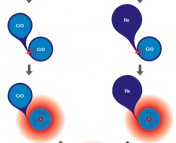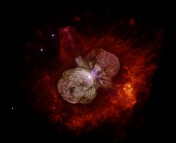- Title: Luminous Supernovae
- Author: Avishay Gal-Yam
- First Author’s Institution: Weizmann Institute of Science, Israel
One of the great things about astronomy is that almost every time we open a new window on the universe – through new types of detectors or improved observing strategies – we seem to discover new and exiting types of phenomena. For the supernovae community, one of the great advances of the past decade was the discovery of a rare class of cosmic explosions which are tens to hundreds of times more luminous than “ordinary” supernovae. The discovery of these super-luminous events was made possible by the implementation of surveys which cover large volumes of the universe in an unbiased way (i.e. they do not target only known bright galaxies as many initial supernovae surveys did). In today’s paper Avishay Gal-Yam of the Weizmann Institute in Israel summarizes what is currently known about super-luminous supernovae and argues that they should be divided into three physical classes. In order for us to understand what makes these bright events so different, we must first review our understanding of what makes ordinary supernovae shine.
What Makes “Normal” Supernovae Shine?
In our current understanding normal supernovae occur either when the core of a massive star collapses or when a white dwarf becomes unstable near the Chandrasekhar mass. These explosions are certainly energetic, but how is that energy actually converted into radiation which we can see? As with all things related to supernovae, the answer depends on the type of supernova.
For supernovae which occur in an environment without hydrogen (Type I in supernova observer speak) the optical light we see is actually created by radioactivity. Many heavy elements are synthesized in supernovae – including elements which are radioactive. Most importantly, supernovae seem to synthesize large amounts of nickel-56, which has a half-life of ~6 days. As this nickel decays to cobalt, it releases gamma-rays which are trapped by the other material ejected by the supernovae. These trapped gamma-rays heat up the surrounding material until it radiates as a blackbody which we can see. In this case the peak magnitude of the supernovae is directly proportional to the amount of nickel-56 synthesized in the explosion.
For supernovae which occur in environments where hydrogen is present (Type II in supernova observer speak), the story is slightly different. Radioactivity does still plays a role at late times, but the presence of hydrogen actually allows for another means of converting explosion energy into radiation. When the initial explosion shock wave passes through the hydrogen envelope it actually heats and ionizes it. The envelope then expands, cools, and eventually recombines – producing a significant amount of optical light. In this case the peak magnitude of the supernovae is the results of both (i) the size of the hydrogen-rich area and (ii) the energy contained within the explosion shock.
What makes Super-luminous Supernovae Shine?
Now that we’ve dealt with normal supernovae, it’s time to tackle the super-luminous events. In the figure to the right Gal-Yam plots example light-curves (brightness versus time) for several types of supernovae, with the luminosity to be officially defined as “super-luminous” marked by the dashed black line. So… what is all the hubbub about? Why can’t these super-luminous events just be “scaled-up” versions of normal supernovae – i.e. explosions with a LOT of nickel or large radii and high explosion energies? It turns out it is slightly more complicated than that. In his review Gal-Yam argues for three classes of super-luminous events: SLSN-R, SLSN-I, and SLSN-II.

Light-curves (brightness versus time) for various types of supernovae. The dashed black line shows the cutoff for classification as "super-luminous".
SLSN-R: These are a class of SLSN which lack hydrogen and whose light-curve decline rates seem to be consistent with being powered by large amounts of nickel-56 (i.e. related to the radioactive half-life; R = radioactive). In order to reach these peak luminosities one needs approximately five solar masses of nickel to be synthesized in the explosion (compared to 0.05 – 1.0 solar masses for most normal supernovae). It would require a very large star to produce that much nickel. In fact, it is still debated whether these events could be pair instability supernovae (see this astrobite).
SLSN-I: These are another class of SLSN which lack hydrogen (I = Type I), but whose decline rates are too fast to be explained solely by the radioactive decay of nickel. Something else must be powering these explosions. This is still an unanswered problem, although several mechanisms have been proposed including (i) the shock interacting with some hydrogen poor material surrounding the star and (ii) somehow extracting the energy from a magnetized and rapidly rotating neutron star.
SLSN-II: These are a class of SLSN which do contain hydrogen (II = Type II). The optical emission is likely produced in a similar manner to the Type II supernovae described above, but in this case the radius of the ”star” would need to be at least an order of magnitude larger than the largest red supergiant currently observed. It is possible these stars are very ”bloated” or that the explosion shock is actually interacting with shells of material ejected from the star before its death. As with the SLSN-I it is still an open question what the underlying explosion mechanism for these events are.
These are clearly very interesting objects, with many unanswered questions surrounding them. I encourage everyone who is interested to read this review.





Trackbacks/Pingbacks